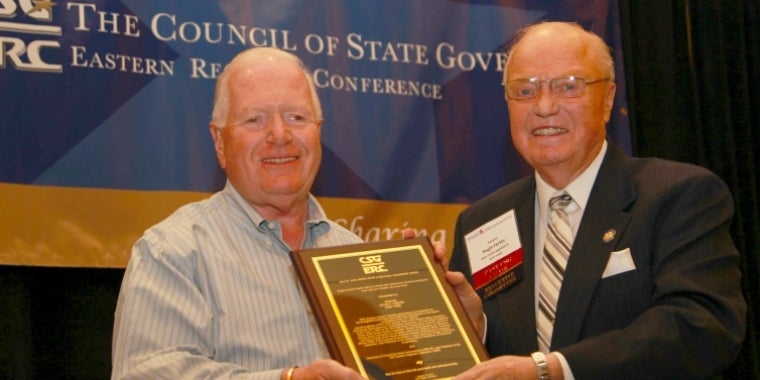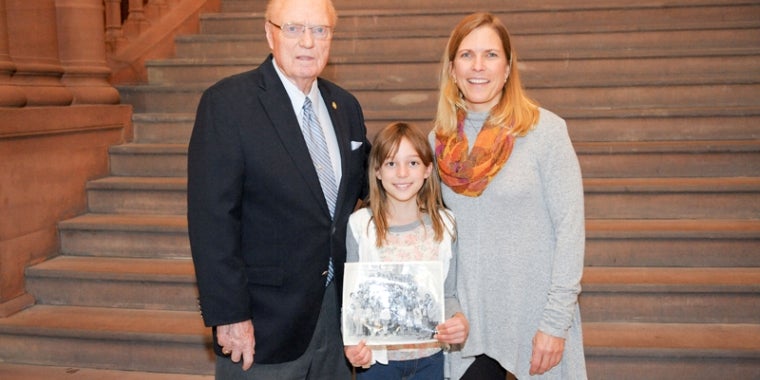
Senator Farley And Governor Pataki Announce $2.42 Million For Brownfield Projects
State Senator Hugh T. Farley (R,C - Schenectady) joined Governor George. E. Pataki recently in announcing more than $2.42 million in Environmental Restoration Program grants for the investigation of contamination at brownfield sites in nine communities across New York State, including a $234,000 for the investigation of environmental contamination at the former Chalmers Knitting Mill complex in Amsterdam, Montgomery County. All the grants are funded through New York’s Environmental Restoration Program, under the Clean Water/Clean Air Bond Act.
"New York State’s Environmental Restoration Program is the best in the nation, helping local communities investigate and remediate contaminated sites, revitalize dormant properties, and improve their quality of life," Governor Pataki said. "Brownfield sites have untapped potential, and the State is working closely with local communities to help them restore and redevelop these properties, and open up new opportunities for recreation and economic development," the Governor said.
In October 2003, Governor Pataki signed historic legislation to refinance and reform the State’s Superfund and Brownfields Program. Under this law, the State provides grants covering up to 90 percent of the cost of investigating contaminated sites.
The Clean Water/Clean Air Bond Act, proposed by Governor Pataki and approved by voters in 1996, authorized $1.75 billion for important environmental programs, including $200 million for the investigation and cleanup of brownfields. Brownfields are abandoned or underused properties where real or perceived environmental contamination hinders the potential for redevelopment.
To date, more than $73 million in Bond Act funding for brownfields has been committed, funding 152 investigation projects and 31 remediation projects. Additional applications are under review by DEC and more grants are expected to be awarded in the near future.
The grants that were recently awarded are:
* City of Amsterdam, Montgomery County -- $234,000 for the investigation of environmental contamination at the former Chalmers Knitting Mill complex, 21-41 Bridge Street and 32 Gilliland Avenue, Amsterdam. The City will investigate the 3.3-acre facility comprised of seven buildings and containing approximately 300,000 square feet of open industrial space adjacent to the Mohawk River. Review of the site history indicates the property was used by the former Chalmers Knitting Company from the 1920s through the 1950s. Areas of potential environmental concern include sumps and floor drains, former dye facilities, underground petroleum storage tanks, electrical transformers, and various wastes and containers throughout the property. The investigation will include the installation of groundwater monitoring wells, groundwater sampling and analysis, sampling and analysis of surface and subsurface soils, evaluation and removal of underground petroleum storage tanks, and the sampling and potential removal of electrical transformers. Once the investigation is complete, a determination will be made on the remediation activities necessary to make the site safe for reuse. The City plans to acquire the vacant property and hopes to redevelop the site to include mixed-use development with commercial, retail, and office facilities, recreational areas, and residential use including senior housing and market-rate condominiums. The Chalmers Building project is part of the Via Ponte Redevelopment, a larger City strategy to redevelop Amsterdam’s south side neighborhoods and waterfront.
* Town of Warrensburg, Warren County -- $348,700 grant to investigate the nature and scope of contamination at a former paper mill on the Schroon River, with the goal of transforming the site into a recreation area with River access.
* Town of Russia, Herkimer County -- $133,220 for the investigation of environmental contamination at the former Salm’s Repair property in the Village of Poland. The Town will be acquiring the 1.0-acre property, which had been operated as a gasoline filling station and vehicle repair shop, with associated underground storage tanks. The investigation will include a geophysical survey to confirm the location of underground storage tanks and fuel lines, and identify utilities and drains. In addition, there will be a complete inspection of the property and the existing buildings; installation of groundwater sampling wells; and soil and groundwater
sampling. The Town plans to redevelop the site as an entranceway to the local school by enhancing traffic flow, improving safety, and enhancing the appearance of the school grounds.
* Town of Clermont, Columbia County -- $99,000 for the investigation of environmental contamination at the former Hettling property, 1795 Route 9, in Clermont. The Town will investigate the 20-acre property, which consists of agricultural land where waste materials including railroad ties and unidentified agricultural process wastes are believed to have been disposed. The investigation will include soil and waste sampling to determine the extent and type of contamination on the site. The Town acquired the property in December 2003 and removed various scrap materials from the site. Plans for redeveloping the property for use as parkland, recreational fields, or municipal buildings.
* City of New York, Bronx County -- $315,000 for the investigation of environmental contamination at the Melrose Commons Urban Renewal Park in the Bronx at 820-832 Melrose Avenue and 400 E. 160th Street. The 1.0-acre site was formerly occupied by auto repair facilities, an iron works factory, and a pickling works facility, and several fuel oil underground storage tanks were used on site. Sample results from preliminary investigations indicated the presence of volatile organic compounds, semi-volatile organic compounds, perchloroethylene, trichloroethene and heavy metals contamination. The grant will fund an additional investigation of site conditions to better determine the environmental impact. This information will be utilized to develop the most effective cleanup plan. The City, which acquired the property in 1998, plans to redevelop the site as part of its Melrose Commons Urban Renewal Park.
* Erie County Industrial Development Agency (ECIDA) -- $134,640 for the investigation of environmental contamination at Parcel 4 in the northern portion of the Buffalo Lakeside Commerce Park in Buffalo. ECIDA will investigate the nearly 20-acre site at 1714 Fuhrmann Blvd, which the city acquired in 1998. This property formerly housed the Hanna Furnace Corporation and a scrap metal salvage company, but was essentially unoccupied from 1986 until the recent construction of the Buffalo Lakeside Commerce Park’s new light industrial facility in the southern portion of the park. The city acquired the property in 1998. To simplify the investigation and redevelopment of the property, the City subdivided it into four parcels, with Parcel 4 being transferred to ECIDA, which will conduct the investigation. Investigations previously performed indicate that soil and fill material in Parcel 4 contain elevated concentrations of various metals. The upcoming investigation will include analyses of the soil and groundwater to determine the concentration and characteristics of the contamination present and appropriate cleanup options.
* The City of New Rochelle and Westchester County -- $882,000 for the investigation of environmental contamination at the David’s Island property in New Rochelle. The City and the County will investigate the property, located about one-half mile east of mainland New Rochelle on Long Island Sound. The property consists of a former military base, Fort Slocum, which operated from 1863 until 1967. The island is now overgrown with vegetation, and contains numerous dilapidated buildings/structures. The City first acquired the property in 1967 upon closure of the Fort Slocum Military Base. Consolidated Edison took ownership in 1968, but the City reacquired the property in 1976. The City/County partnership plans to remediate the property prior to transferring ownership to Westchester County, which plans to redevelop the island as a public park. Historical sources of contamination may be attributable to the prior storage of transformers, several on-site aboveground and underground storage tanks, a former on-site incinerator, use and storage of pesticides, and landfill activities. The U.S. Army Corps is currently funding a number of activities including building demolition, debris removal, establishment of a staging area, and removal of asbestos-containing materials.
* Schuyler Heights Fire District, Albany County -- $105,300 for the investigation of environmental contamination at a vacant, 7.5-acre parcel at 849 First Street in the Town of Colonie. Preliminary environmental investigations performed by the fire district have provided a detailed history of the site and preliminary description of the contamination present. It is believed that the property was previously used as a rail yard loading and unloading facility and as a scrap metal recovery operation. The fire district purchased the property in May 2005 and plans
to construct a new fire station and rescue facilities following the investigation and cleanup of the property, and approval of local officials. The grant will fund further sampling to better characterize the extent of contamination and help to determine the best cleanup plan for the site.
* City of Rochester, Monroe County -- $169,876 for the investigation of environmental contamination at the Orchard-Whitney site in Rochester. The property consists of two parcels with a combined area of 3.9 acres located at 354 Whitney Street and 415 Orchard Street. The City will investigate both properties. The site had various commercial and industrial uses since the early 1900s including tool and die shops, plastics manufacturing, printing operations, metal finishers, electric company and warehousing. Both parcels have been vacant since the mid-1990s. An initial environmental investigation conducted by the City indicated the presence of polychlorinated biphenyls (PCBs), heavy metals, solvents and petroleum contamination. The City will acquire temporary ownership of the site to carry out the investigation. This site is located with the Lyell-Lake-State Street Brownfield Opportunity Area and is within 2,000 feet of the $23 million Rochester Rhinos Stadium Project. The investigation will include: characterization of soil and groundwater to determine the nature and extent of site-related contaminants; an asbestos survey of the remaining structures; and a PCB assessment of the former power plant. The information gathered during the investigation will be used to develop an appropriate remedy to clean up the site for future commercial/industrial use.



